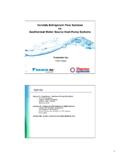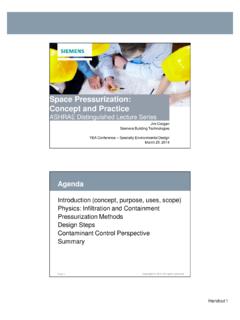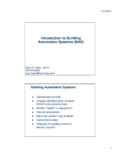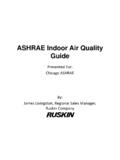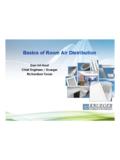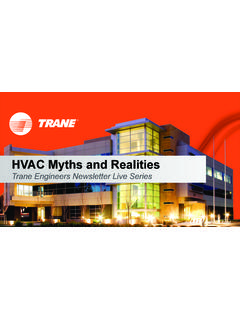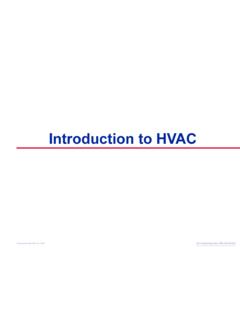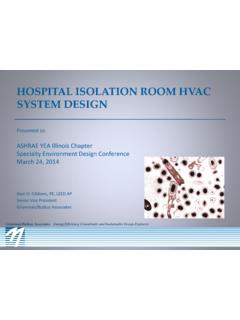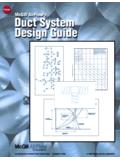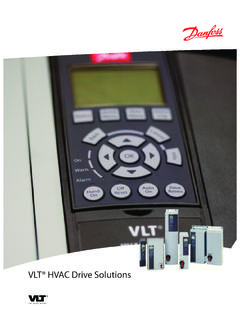Transcription of INTRO TO CONSTANT VOLUME AND VAV SYSTEMS
1 INTRO TO CONSTANT VOLUME AND VAV SYSTEMS Frank Moccio Primera Engineers Objectives Define CONSTANT VOLUME and VAV SYSTEMS Describe Different Control Strategies for Modulating Supply airflow Discuss Building Pressure Control Strategies Complying with Min OA Requirements Define Coil Controls Best Practices Discuss Safeties When and How Review AHU Schematics and Points Lists CONSTANT VOLUME SYSTEMS CONSTANT VOLUME system Air Movement Supply Air Return Air Supply Fan CONSTANT VOLUME system Air Movement + Ventilation Supply Air Return Air Supply Fan Outside Air CONSTANT VOLUME system Air Movement + Ventilation + Heating/Cooling Outside Air Supply Air Return Air Supply Fan Cooling and Heating Coils CONSTANT VOLUME system Air Movement + Ventilation + Heating/Cooling + Filtration Filter Outside Air Supply Air Return Air Supply Fan Cooling and Heating Coils CONSTANT VOLUME system Control: Space Temperature Staged Cooling and Heating Thermostat Cooling 74 F Heating 72 F ON/OFF Control of Cooling, Heating, Fan CONSTANT VOLUME system Control: Space Temperature Thermostat Staged Cooling and Heating Time Leaving Air Temperature 72 F 55 F 90 F CONSTANT VOLUME system Control: Space Temperature Thermostat Staged Cooling and Heating Time Space Temperature 72 F 70 F 74 F Hysteresis Hysteresis CONSTANT VOLUME system Control.
2 Space Temperature Modulating Control Setpoint Controller Space Setpoints: Cooling 74 F Heating 72 F Modulating Heating: Hot Water Steam Modulating Gas Face and Bypass Modulating Cooling: Chilled Water Space Temp Setpoint Controller: Compares Value to Target 0-100% Signals CONSTANT VOLUME system Time Leaving Air Temperature 72 F 55 F 90 F Control: Space Temperature Modulating Control CONSTANT VOLUME system Time Space Temperature 72 F 70 F 74 F Hysteresis Hysteresis Control: Space Temperature Modulating Control CONSTANT VOLUME system Control: Leaving Air Temperature (Master/Slave) Setpoint Controller Space Setpoints: Cooling 74 F Heating 72 F T Space Temp Space Temp calculation determines LAT setpoint.
3 Control to LAT LAT Setpoints: Cooling 55 F 65 F Heating 75 F 90 F 0-100% Signals CONSTANT VOLUME system Time Leaving Air Temperature 72 F 55 F 90 F Control: Leaving Air Temperature (Master/Slave) CONSTANT VOLUME system Time Space Temperature 72 F 70 F 74 F Hysteresis Hysteresis Control: Leaving Air Temperature (Master/Slave) CONSTANT VOLUME system Zone Reheat Space Control T T T T-stat T-stat T-stat T-stat Pros: Simple Comfortable Cons: Highly Inefficient CONSTANT VOLUME system Zone Reheat Space Control T T T Setpoint Controller Setpoint Controller Setpoint Controller Setpoint Controller CONSTANT VOLUME system Zone Reheat LAT Control T T T T T T T Setpoint Controller Setpoint Controller Setpoint Controller Setpoint Controller Va r i a b l e A i r VOLUME (VAV) SYSTEMS VAV system Basic Concept Space Temp Space Temp Space Temp Space Temp Supply airflow Modulation Pressure Sensor PVAV system airflow Modulation: Discharge Damper MIncrease Resistance Variable airflow VAV system airflow Modulation.
4 Discharge Damper Full Speed Discharge Damper Full Open Full Speed Discharge Damper Partially Closed VAV system airflow Modulation: Adjustable Sheaves Change Fan Rotational Speed Variable airflow VAV system airflow Modulation: Adjustable Sheaves Full Speed Motor Sheave Normal Full Speed Motor Sheave Reduced VAV system airflow Modulation: Bypass Damper MConstant airflow Variable airflow VAV system airflow Modulation: Bypass Damper Full Speed Bypass Closed Full Speed Bypass Partially Open VAV system airflow Modulation: Inlet Guide Vanes (IGV) Variable airflow Change Properties of Fan MVAV system airflow Modulation: Inlet Guide Vanes (IGV) Full Speed IGVs Full Open Full Speed IGVs Partially Closed VAV system airflow Modulation: Variable Frequency Drive (VFD) Va r i a b l e airflow VFD Power In Change Fan Rotational Speed Change Motor Rotational Speed VAV system airflow Modulation.
5 Variable Frequency Drives Full Speed VFD at Full Speed Full Speed VFD at Reduced Speed VAV system Return Fan Return Fan Typically Less airflow than Supply Fan, Less HP Covers Static of Return Ductwork VAV system Building Pressure Control Fan Tracking VFD VFD Supply Fan 100% Return Fan 80% Supply Fan 80% Return Fan 64% Supply Fan 60% Return Fan 48% P80% of Supply Fan VAV system Space Pressure High Port Low Port Reference to Ambient Building Pressure Control Space Pressure VFD VFD PVAV system High Port Low Port AFMS AFMS PVFD VFD Building Pressure Control CFM Differential CFM Differential = 500 Supply Air 8000 CFM Return Air 7500 CFM CFM Differential = 2000 Supply Air 8000 CFM Return Air 6000 CFM Return Fan Controls to Return Air CFM VAV system Building Pressure Control CFM Differential The Return airflow shall track the supply airflow
6 Less the direct exhaust with an offset ( CONSTANT ). Use the following formula to determine the desired Return Air CFM Setpoint: RA-CFM-SP = K x (SA-CFM DE-CFM) K = Multiplier, reset between and as determined through test and balance to maintain positive pressure in occupied area (relative to ambient pressure) Direct exhaust CFM shall be determined by monitoring ON/OFF statues of exhaust fans and incorporating EF-CFM from T&B Report. VAV system Damper Control Control Points MMMC ontrol All Dampers with One Signal Simpler Approach AO Control Point VAV system Damper Control Control Points MMMC ontrol Dampers with Independent Signals Offers Greater Flexibility AO AO AO VAV system OA Damper Control Minimum Air Fixed Position MMMM inimum Air Control Control to Fixed Position Outside Air Exhaust Air 37% 63% 37% Design = 8,000 CFM Design = 3,000 CFM VAV system OA Damper Control Minimum Air Fixed Position MMMM inimum Air Control Control to Fixed Position Outside Air Exhaust Air 37% 63% 37% Actual = 5,000 CFM Design = 3,000 CFM Actual = 1,850 CFM VAV system OA Damper Control Minimum Air - AFMS MMMM inimum Air Control.
7 Control to Maintain OA-AFMS Setpoint Outside Air Exhaust Air 60% 40% 60% Actual = 5,000 CFM Design = 3,000 CFM AFMS Setpoint = 3,000 CFM VAV system RA Damper Control Track Opposite OA Damper MMMS upply Fan Sees Equal Resistance as Dampers Modulate Outside Air Exhaust Air 37% 63% 37% Actual = 8,000 CFM AFMS Setpoint = 3,000 CFM VAV system RA Damper Control Alternate Control Strategy MMMS upply Fan See Less Resistance Less Work / Energy Consumption Outside Air Exhaust Air 57% 100% 57% Actual = 8,000 CFM AFMS Setpoint = 3,000 CFM VAV system Leaving Air Temperature (LAT) Control Chilled Water Coil 3-Way Valve MMMC ontrol to LAT Setpoint - 55 F is typical. MCHW Supply CHW Return T VAV system Leaving Air Temperature (LAT) Control Chilled Water Coil 2-Way Valve MMMC ontrol to LAT Setpoint - 55 F is typical.
8 MCHW Supply CHW Return T VAV system Leaving Air Temperature (LAT) Control Hot Water Coil Freeze Protection Pump MMMC ontrol to LAT Setpoint - 85 F is typical MHW Supply HW Return T Start HW Circ Pump: Heating Mode Freeze Stat OAT < 40 F VAV system Low Temperature Thermostat Freeze Stat MMMFRZ Action when Freeze Stat Trips: HW Circ Pump Starts HW Valve Full Open CHW Valve Open? OAD / EAD Close Supply and Return Fans Stop Trip Setpoint: 35 F to 40 F VAV system Smoke Detectors MMMA ction when Smoke Detectors Trips: Supply and Return Fans Stop SMK SMK VAV system Filter Differential Pressure Monitoring MMMD ifferential Pressure Switch Or Differential Pressure Transmitter DPT Differential Pressure Switch: Less Expensive Trip Point Not Always Set Properly Difficult to Commission Differential Pressure Transmitter: More Expensive No Trip Point Compared to Alarm Value Easier to Commission DPS VAV system Static Pressure Reset Space Temp Space Temp Space Temp Space Temp Pressure Sensor Setpoint = PSupply Duct Static Pressure Setpoint.
9 Normally a Fixed Value ( ) Can be Reset Based on VAV Boxes 100% 75% 35% 62% Speed = 85% 1,000 CFM 750 CFM 350 CFM 620 CFM VAV system Static Pressure Reset Space Temp Space Temp Space Temp Space Temp Pressure Sensor Setpoint = PAs Boxes Close, Speed is somewhat Reduced, but Static Pressure Setpoint is Unchanged. 60% 40% 35% 50% Speed = 75% 600 CFM 400 CFM 350 CFM 500 CFM VAV system Static Pressure Reset Space Temp Space Temp Space Temp Space Temp Pressure Sensor Setpoint = PReduce Static Pressure Setpoint until at least 1 box is full open Power Input to VFD reduced by the Cube of CFM Reduction Speed Reduced 1/2, Power to 1/8. 100% 65% 55% 75% Speed = 50% 600 CFM 400 CFM 350 CFM 500 CFM VAV system Static Pressure Reset When the supply fan is running in the occupied mode, initially control VFD speed to maintain initial static pressure setpoint ( ).
10 Monitoring the positions of the VAV and FPB primary air dampers. If ALL dampers are maintaining airflow setpoint and all dampers are positioned less than 90% open, reset the duct static pressure setpoint down in a gradual manner. If ANY damper is indexed to 100% and cannot maintain its primary airflow setpoint, reset the duct static pressure setpoint UP in a gradual manner. The duct static pressure setpoint shall remain unchanged if: All primary air dampers are indexed to less than 100%, AND At least one damper is indexed greater than 85% Set minimum and maximum allowable ranges for the duct static pressure setpoint. Initially set minimum at and maximum at VAV system High/Low Pressure Safeties MMMA ction when Pressure Safety Trips: Supply and Return Fans Stop HPS LPS HPS LPS Hardwire directly to VFDs Use Relay Logic VFD VFD VAV system Other Considerations: Demand Control Ventilation Control OA airflow based on Carbon Dioxide (CO2) Level in the Occupied Space.

